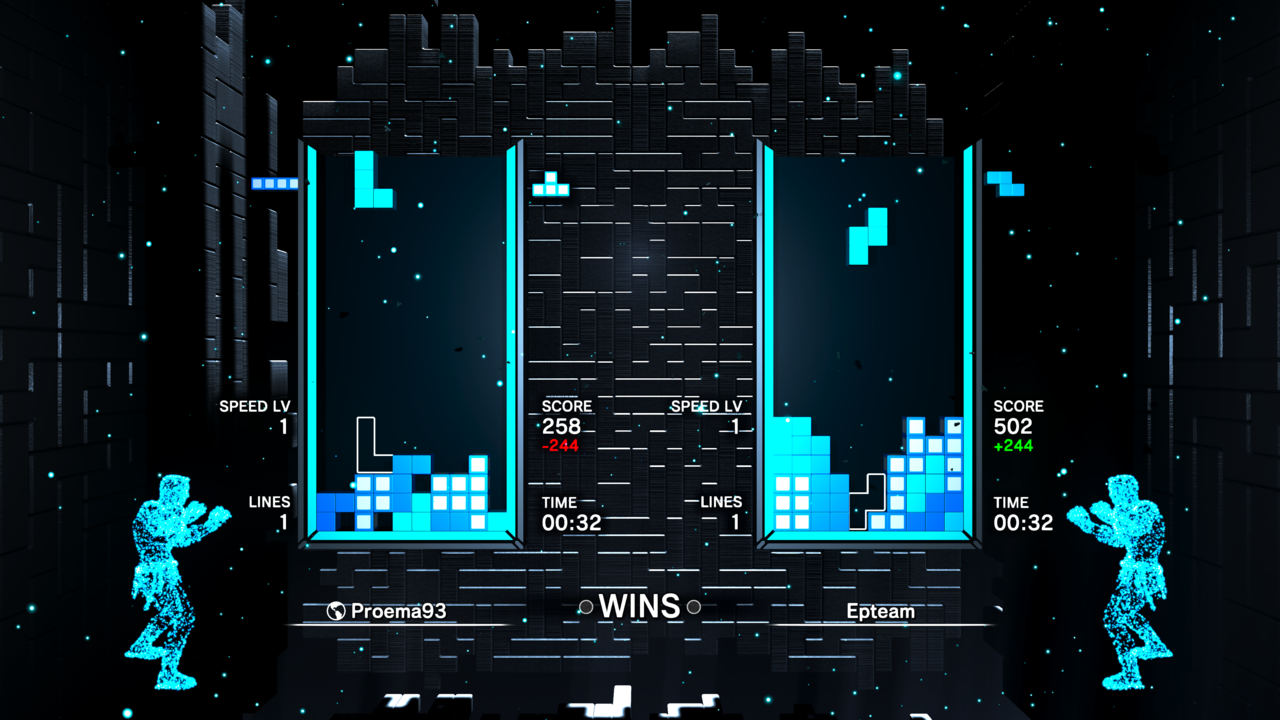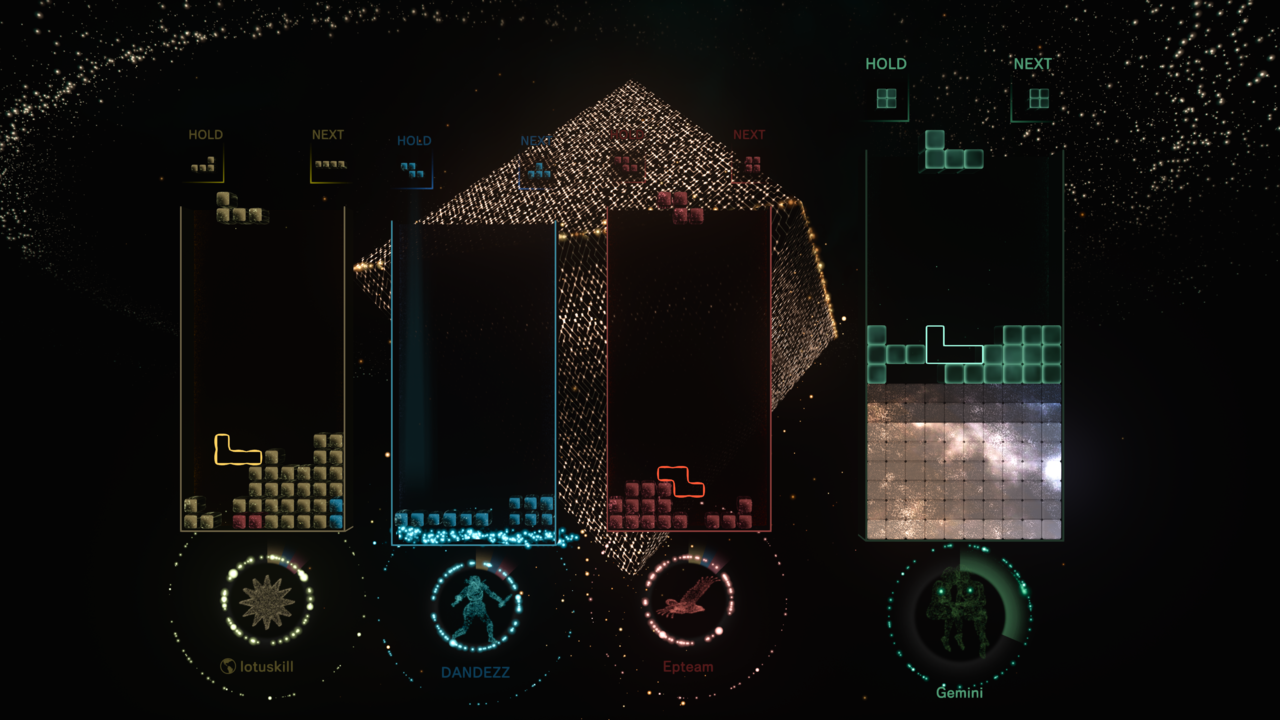This review has been updated to include impressions of the new Nintendo Switch version of Tetris Effect: Connected released in 2021. The initial review, written by Mike Epstein in 2020, follows. The new text, written by Chris Pereira, has been added at the bottom of the original review.
In 2018, Tetris Effect's mesmerizing sounds and sights heightened the classic game's aesthetically pleasing properties and its ability to consume our attention to almost therapeutic levels, reinvigorating our appreciation for one of gaming's oldest obsessions. But even as former GameSpot editor Peter Brown proclaimed Tetris "better than ever" in Tetris Effect, he noted it "sadly" did not apply its wondrous approach to multiplayer. Two years later, Tetris Effect: Connected--an updated re-release for Xbox consoles and PC--fills that gap. Just as the original did for the classic version of the game, Connected reimagines Tetris multiplayer with flair and vision. It also loses a major component, VR support, which delivers the most intense version of the experience. While I'm of two minds on that tradeoff, the soothing intensity of Tetris Effect hasn't lost any potency. On the contrary, it feels more vital than ever in 2020.
Though it adds and removes modes whole cloth, the core of Tetris Effect remains unchanged. Despite the fact that Journey mode hasn't been touched, its shifting, syncopated themes enraptured me level by level, even on my second time through. Tetris Effect is a significant challenge to average Tetris players like myself. Each level revs the speed up to push you just up to the edge of what you can handle. Even as you improve--and you are getting better, whether you see it or not--the levels scale to demand your full focus. It sounds unapproachable, but there's something about the combination of the way your brain looks for patterns, combined with the rhythmic sensory elements and this challenge, that lets you give yourself over to the game, almost trance-like, without even trying.
You'll need that focus in multiplayer. Whether you're playing cooperatively with other players or competing against them, the multiplayer modes in Connected ratchet up the intensity found in the original. Connected features four multiplayer modes--three competitive, one co-op. As in most games, other players will push you in ways a single-player campaign will not.

Most players will rush right to Zone Battle, an updated version of what I imagine when I think of competitive Tetris, a survival mode where completing lines on your field creates extra garbage lines for your opponents. The Connected version adds the zone mechanic from Tetris Effect, which stops the parade of pieces and allows you to complete a large number of lines in a short time. Using zone effectively adds an extra layer of strategy: Activating it at the right time can guarantee a victory, but it's surprisingly tricky to find the correct moment to use it. Though it seems like the ability to save up and cash in lines would only intensify the dominance of elite players, I found it allowed you to turn a good flow into a meaningful attack, regardless of whether you're winning or losing. It won't keep a superior player from stomping you, mind you, but zone rewards players who can be mindful of the situations on both fields and retain the focus to clear lines.
In addition to Zone Battle, Connected also has two versions of Score Attack, a more traditional competitive mode without garbage-line or zone mechanics. In standard Score Attack, you play for the high score and survival. In Classic Score Attack, you do the same, but with the original 1984 rules, so you can't bank pieces, use T-Spins, and so on.
Zone Battle is an interesting riff, but it's a known quantity. The most interesting mode--this game's crown jewel--is the eponymous Connected co-op mode, where three players collectively try to outlast a series of AI opponents, one at a time. At first, the four players simply play Tetris. The AI enemies, named after the signs of the Zodiac, have special abilities called “blitzes” to make things difficult for you, which range from annoying parlor tricks like moving your field up and down to genuinely infuriating maneuvers like temporarily increasing the speed of your drops to force errors. Once a week, there's also an asynchronous Connected Versus mode, where players can spar 3-on-1.
When the three human players clear enough lines on their fields, you automatically trigger a special form of the zone ability, which combines all three of your fields into one. You and your partners take turns placing pieces on the extra-wide field and must clear extra-long lines. Like every level and mode in Tetris Effect, you need to find a natural rhythm in the game, but in this case you do so by getting in sync with your partners. Only one person plays a piece at a time, so being able to quickly find the right spot and anticipate where the others will go becomes crucial. Like zone battle, you need to be focused to fill gaps quickly, but also mindful of the whole field and what's happening.

In most games, that kind of coordination would require voice chat, but this particular mode benefits from relying on non-verbal communication. It requires more awareness and consideration of your fellow players than the competitive modes because you're sharing a single field. The goal of Tetris Effect, across its modes, is to feel the flow of the game without interruption or getting into your own head; silently syncing with your partners, showing them what you plan to do with your next piece and trusting that they'll understand and plan around that offers an interesting variation on that theme, and it can create incredible results if you can... connect.
Since it's a re-release, we should also talk about what's missing from Connected. Unlike the original release, Tetris Effect isn't playable in virtual reality. Since Connected is primarily an Xbox release, removing VR seems like a practical decision: The Xbox consoles don't support VR headsets, so only PC players would be able to enjoy it. In the original Tetris Effect, VR felt like the coup de gras, tuning you into the game intensely by letting you see and hear the levels all around you. It's a unique experience, and part of the magic of the original version. While I think multiplayer is the more approachable feature, and what I would want if forced to choose, I do wish there were a way to have both in a single package.
But there's no time for regrets in Tetris. The next piece is falling and you only have a few seconds to put it in place. Then the next piece, and the one after that. Some people meditate to clear their minds. Other people cook, or build models. Tetris Effect has a similar capacity to clear your mind. In 2018, that made Tetris Effect feel special. In 2020, it feels essential.
Tetris Effect: Connected On Nintendo Switch
Tetris Effect: Connected on Nintendo Switch is exactly what you would hope it'd be. The full game makes the move to the portable hybrid console, and despite my concerns that it would lack the visual fidelity necessary to recreate the transcendent experience that Effect provides elsewhere, the Switch version is more than capable. Audio lacks a bit of punch when using the system's built-in speakers, but the ability to play Effect on the go more than makes up for that.

The new multiplayer modes introduced in Connected are all present here, and fortunately, they come equipped with cross-play support, helping to ensure you don't have problems finding other players (though I did encounter the occasional server issue).
It may lack some of the visual flair seen on more powerful platforms, and in handheld mode, headphones are all but necessary to appreciate the intense rhythm of levels like Ritual Passion that rely so heavily on the blend of hypnotic visuals and incredible audio to deliver Effect's uniquely euphoric experience. But even with those minor caveats, Effect remains the best version of Tetris out there, and Switch is a great place to play it.







